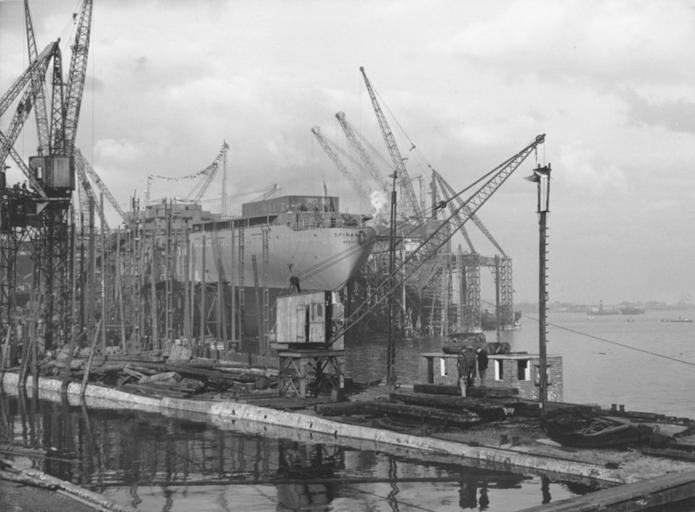MAKE A MEME
View Large Image

| View Original: | The_tanker_'Spinanger'_ready_for_launch.jpg (791x583) | |||
| Download: | Original | Medium | Small | Thumb |
| Courtesy of: | www.flickr.com | More Like This | ||
| Keywords: sunderland shipbuilding river wear riverwear j.l. thompson & sons ltd jlthompsonsonsltd north sands sunderland northsandssunderland shipyard cranes wearside spinanger tanker industry industrial black and white photograph blackandwhitephotograph north sands northsands maritime abstract launch 22 october 22october 1957 tugboats vessel boat ship industrial action industrialaction wear tugboatmen weartugboatmen 1846 robert thompson & sons robertthompsonsons iron metal crane construction platform timber river bank porthole rail cabin deck cargo doorway glass land mast water flags rope reflection wire unusual interesting workmen crew steam smoke pole peg bolt plate plank log daylight standing observing working attentive hook cog opening coat trousers hat man slope grain blackandwhite monochrome outdoor black and white View of the tanker ‘Spinanger’ ready for launch at the North Sands shipyard of J.L. Thompson & Sons, Sunderland, 22 October 1957 (TWAM ref. DS.JLT/4/PH/1/694/2/2). The launch of 'Spinanger' was unusual in that it was carried out without the assistance of tugboats. This was due to industrial action by the Wear tugboatmen. This set celebrates the achievements of the famous Sunderland shipbuilding firm Joseph L. Thompson & Sons. The company’s origins date back to 1846 when the firm was known as Robert Thompson & Sons. Robert Thompson senior died in 1860, leaving his second son Joseph Lowes Thompson in control. In 1870 the shipyard completed its last wooden vessel and was then adapted for iron shipbuilding. By 1880 the firm had expanded its operations over much of North Sands and in 1884 completed the construction of Manor Quay, which served as fitting out and repair facilities. For many years in the late nineteenth century the yard was the most productive in Sunderland and in 1894 had the fourth largest output of any shipyard in the world. The Depression affected the firm severely in the early 1930s and no vessels were launched from 1931 to 1934. However, during those years the company developed a hull design giving greater efficiency and economy in service. During the Second World War the prototype developed by Joseph L. Thompson & Sons proved so popular that it was used by the US Government as the basis of over 2,700 Liberty ships built at American shipyards between 1942 and 1945. After the War the North Sands shipyard went on to build many fine cargo ships, oil tankers and bulk carriers. Sadly the shipyard closed in 1979, although it briefly reopened in 1986 to construct the crane barge ITM Challenger. (Copyright) We're happy for you to share these digital images within the spirit of The Commons. Please cite 'Tyne & Wear Archives & Museums' when reusing. Certain restrictions on high quality reproductions and commercial use of the original physical version apply though; if you're unsure please email archives@twmuseums.org.uk View of the tanker ‘Spinanger’ ready for launch at the North Sands shipyard of J.L. Thompson & Sons, Sunderland, 22 October 1957 (TWAM ref. DS.JLT/4/PH/1/694/2/2). The launch of 'Spinanger' was unusual in that it was carried out without the assistance of tugboats. This was due to industrial action by the Wear tugboatmen. This set celebrates the achievements of the famous Sunderland shipbuilding firm Joseph L. Thompson & Sons. The company’s origins date back to 1846 when the firm was known as Robert Thompson & Sons. Robert Thompson senior died in 1860, leaving his second son Joseph Lowes Thompson in control. In 1870 the shipyard completed its last wooden vessel and was then adapted for iron shipbuilding. By 1880 the firm had expanded its operations over much of North Sands and in 1884 completed the construction of Manor Quay, which served as fitting out and repair facilities. For many years in the late nineteenth century the yard was the most productive in Sunderland and in 1894 had the fourth largest output of any shipyard in the world. The Depression affected the firm severely in the early 1930s and no vessels were launched from 1931 to 1934. However, during those years the company developed a hull design giving greater efficiency and economy in service. During the Second World War the prototype developed by Joseph L. Thompson & Sons proved so popular that it was used by the US Government as the basis of over 2,700 Liberty ships built at American shipyards between 1942 and 1945. After the War the North Sands shipyard went on to build many fine cargo ships, oil tankers and bulk carriers. Sadly the shipyard closed in 1979, although it briefly reopened in 1986 to construct the crane barge ITM Challenger. (Copyright) We're happy for you to share these digital images within the spirit of The Commons. Please cite 'Tyne & Wear Archives & Museums' when reusing. Certain restrictions on high quality reproductions and commercial use of the original physical version apply though; if you're unsure please email archives@twmuseums.org.uk | ||||